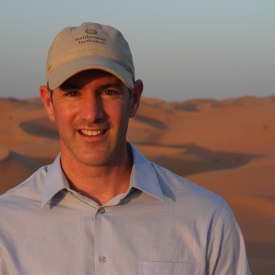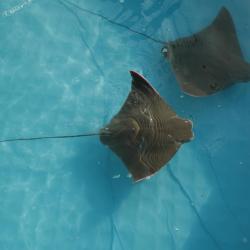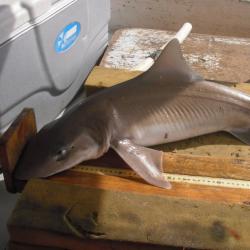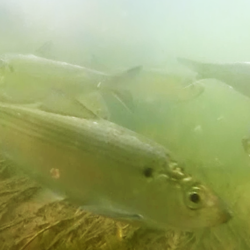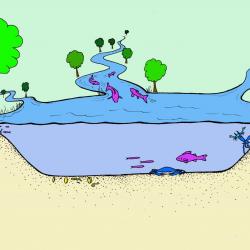The Fisheries Conservation Lab investigates the ecology, management, and conservation of marine and estuarine fisheries. We depend on fisheries for many things including food, employment, recreational opportunities, and culture, but fishing and aquaculture rank among the greatest human impacts on marine ecosystems. Finding a balance between harvest and conservation of fishery species and mitigating the impacts of fisheries on marine ecosystems will be key to sustaining productive, resilient coastal and marine ecosystems for future generations.
Our interdisciplinary research focuses on providing the best scientific information available to inform fisheries management and conservation decision-making at scales from local communities to global institutions. We apply field and laboratory studies, emerging technologies, models, and historical perspectives across four research themes: 1) fisheries science, 2) movement ecology, 3) ecological restoration, and 4) long-term dynamics of coastal ecosystems.
We engage in research collaborations with individual researchers and organizations, as well as through major research initiatives and networks:
Chesapeake Bay River Herring Migrations
Posted by Gabe Stephenson on July 30, 2025

The Chesapeake Bay river herring migration study uses acoustic telemetry to track migrations of river herring tagged on spawning grounds in Chesapeake Bay tributaries.
The project will provide crucial information on the annual migration cycle from individual rivers to open ocean, supporting efforts to rebuild stocks of this economically, ecologically, and culturally important species group.
River herring is the common name for two species: alewife (Alosa pseudoharengus) and blueback herring (Alosa aestivalis). These species are anadromous, meaning that they spend their adult lives in the ocean and migrate into freshwater rivers and streams to spawn.
River herring were once abundant in Chesapeake Bay, making up an important food source for wildlife and people alike. Overfishing, habitat fragmentation due to dams and other impediments to migration, and habitat degradation have resulted in sharp declines in river herring populations. These declines have caused tremendous economic and cultural loss, limiting fishing revenue and threatening fishermen’s way of life. Despite a moratorium on river herring fishing and extensive fish passage improvements in the bay and its tributaries, populations have struggled to rebound. Because of their migratory nature, the challenges that Chesapeake Bay river herring face today may be happening hundreds of miles from the bay.
Acoustic telemetry is a powerful tool that can provide information on the migrations of individual fish throughout their annual migration. A paper published in 2024 as a part of the project was the first to track habitat use of individual alewife throughout their entire migration. Alewife tagged in the Choptank River, MD were tracked as far north as the Gulf of Maine and Bay of Fundy, Canada, passing through most of the footprint of the Atlantic Cooperative Telemetry Network and venturing into the neighboring Ocean Tracking Network.


The results of the project have important management implications for river herring. Their migration takes them through waters which are undergoing rapid warming, across multiple fisheries management jurisdictions, and through regions with potentially high levels of incidental bycatch. Understanding their migratory patterns and timing provides fishery managers with new information to support actions that protect the fish along their journey.
Ongoing and future studies track both alewife and blueback herring from multiple Chesapeake Bay tributaries. As of May 2025, 450 river herring have been tagged in the Choptank, Patapsco, Potomac, and Rappahannock rivers.
The project is conducted by the Smithsonian Environmental Research Center, in collaboration with the Rappahannock Tribe and George Mason University. Funding was provided by the Smithsonian Institution Office of the Under Secretary for Science, NOAA National Marine Fisheries Service and National Fish and Wildlife Foundation. For more information, visit ACT Network projects CBALE, CBRIVERS24, and RAPPTRIBE.
Fisheries Science
Understanding the ecology of fisheries is critical to maintaining resilient, productive coastal and marine ecosystems. Fishing is an important sector of coastal economies, provides an important supply of food for human societies, and is an activity of great cultural and historical importance. But fisheries have also contributed to the decline of coastal and marine ecosystems through changes in biomass and community structure, disruption of food webs, and alteration of habitats. Using the Chesapeake Bay as a model system, we are addressing fisheries issues including the impacts of harvest, restoration, and conservation on populations, communities and ecosystems, habitat use, migrations and connectivity with other coastal ecosystems. To learn more about our fisheries ecology and conservation research, please visit the following webpages:
Movement Ecology
Many species on the planet migrate during their lifetime, using different habitats during specific life stages. What habitats are most important and why? What environmental cues are migratory species responding to? What are the benefits and costs of migration to individuals? How can we best manage fisheries for migratory species? How do migratory species affect community structure and ecological processes? To learn more about our movement ecology research at Smithsonian, please visit the Movement of Life Initiative and Mid-Atlantic Marine Biodiversity Observation Network webpages.
Ecological Restoration
Restoring coastal ecosystems has the potential to reverse centuries of habitat degradation and loss of ecosystem services. We are studying outcomes of oyster reef restoration and river restoration to determine if restoration efforts meet project goals. We also develop and test new, more efficient methods for evaluating restoration outcomes.
Long-Term Dynamics of Coastal Ecosystems
Our long-term studies of coastal ecosystems offer a window into the ecology of one of the most productive ecosystems on earth, the Chesapeake Bay, and US mid-Atlantic coast. Spanning more than four decades, this research tracks seasonal, annual, and decadal variation in habitats, species composition, and abundance of fishes and macro-invertebrates. Sampling methods include trawling, seining, dive surveys, benthic infauna cores, tethering experiments, environmental DNA, and passive acoustic monitoring. The long-term data, in combination with our experimental studies, provide an unusual database for exploring populations, communities, predator-prey relationships, impacts of fisheries, and ecological processes. To learn more about our long-term research, please follow the links below:
Welcome to the Educator Resources page-- below are a collection of lessons, web resources, and videos arranged by subject to help you quickly find resources in your interest area to create lesson plans or activities. Maryland follows the Next Generation Science Standards for K-12 science content standards. Access the Next Generation Science Standards broken down by topic at the National Science Teachers Association website.
Are you a teacher visiting SERC? Click here to learn more about how to prepare for your field trip to our campus and other general resources!
Discover, create, and share more resources and educational experiences on the Smithsonian Learning Lab!
Sharks, rays, and whales
Lesson: Movement of Life Initiative: Protecting Whales
Grade 3
NGSS, Computer Science Teachers Association Standards, ISTE Student Standards
https://ssec.si.edu/whales
Lesson: Movement of Life Initiative: Discover What Makes Sharks Move
Grade 4
NGSS
https://learninglab.si.edu/collections/movement-of-life-initiative-discover-what-makes-sharks-move/74MV9mDjnp7PvG9k#r
Lesson: Sharks and Shorelines
Grades 6-10
NGSS
https://natureworkseverywhere.org/resources/sharks-shorelines/
Activity: Ecosystem Explorer | EARTH A New Wild
Grades 5-8
NGSS
https://www.pbslearningmedia.org/resource/5aeed659-7f0b-417f-81d9-5f2e9c...
Reading/ Video: SERC’s Shorelines Blog "Following the Movement of Life: Tagging Sharks and Rays"
Grades 5-7
https://sercblog.si.edu/?p=8571
Reading/ Video: SERC’s Shorelines Blog "Tracking the Bay’s Cownose Rays"
Grades 5-7
https://sercblog.si.edu/?p=6254
For more information about shark migration, check out Smithsonian's Movement of Life Initiative!
Blue Crabs
Lesson: The Blue Crab's Chesapeake Journey
Grade 9-12
http://www2.vims.edu/bridge/DATA.cfm?Bridge_Location=archive1102.html
Video: SERC Scientists Video from the Smithsonian Science Education Center, “How do Scientists Track and Monitor blue Crab Populations in the Chesapeake Bay?
Grades 3-8
https://ssec.si.edu/explore-smithsonian-how-do-scientists-track-and-moni...
Video: SERC Ecosystems on the Edge video by one of our scientists, called “Blue Crabs: Top Predator in Peril”
Grades 3-8
https://ecosystemsontheedge.org/top-predator/
Oysters
Lesson: Juvenile Oyster Disease: A Growing Problem
Grade 9-12
https://masweb.vims.edu/bridge/datatip.cfm?Bridge_Location=archive0103.html
Video: Determining the Resiliency of Juvenile Oysters in the Chesapeake Bay
Grade 3-8
Activity Book: The World is Your Oyster: Activity and Coloring Book
Grade 2-5
https://serc.si.edu/sites/default/files/website-gen/fish_con_coloring_booklet_final.pdf






